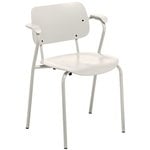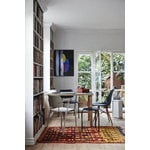Artek’s Lukki chair, designed by Ilmari Tapiovaara in 1951, is a thin-legged classic of Finnish design – Lukki is Finnish for daddy longlegs. The frame is made of painted steel tube and the seat and backrest are beech-veneered, form-pressed birch plywood. Lukki chairs and stools were originally designed for student dormitories of the Helsinki University of Technology, and their most essential qualities are versatility, stackability and durability. The short armrests of Lukki allow the chair to be pulled close to a table and make it pleasant for dining as well as reading.


Lukki chair, stone white
Artek
Description
Artek’s Lukki chair, designed by Ilmari Tapiovaara in 1951, is a thin-legged classic of Finnish design – Lukki is Finnish for daddy longlegs. The frame is made of painted steel tube and the seat and backrest are beech-veneered, form-pressed birch plywood. Lukki chairs and stools were originally designed for student dormitories of the Helsinki University of Technology, and their most essential qualities are versatility, stackability and durability. The short armrests of Lukki allow the chair to be pulled close to a table and make it pleasant for dining as well as reading.
Product details (10)
- Colour
- Stone white
- Width
- 56 cm
- Depth
- 51 cm
- Height
- 74 cm
- Seat height
- 43 cm
- Armrest height
- 66.5 cm
- Frame material
- Steel tube
- Seat material
- Beech veneered form pressed birch plywood
- Weight
- 5.5 kg
- Stackable
- Yes, 4 pcs
- Product ID
Designer
Ilmari Tapiovaara (1914-1999) was a renowned Finnish interior architect and designer. In his designs, Tapiovaara always sought to create a humane, well-lit and warm dwelling environment. Tapiovaara’s furniture pieces designed were always part of a whole, with the architecture as their starting point.
Ilmari Tapiovaara graduated in 1937 as interior architect from the department of furniture design of the Central School of Arts and Crafts. After graduating, he visited the Paris World’s Fair and during his stay in France he got an assistant’s position for six months at the office of Le Corbusier. Soon after coming back to Finland, Tapiovaara was hired by the Asko company, Finland’s largest furniture factory, where he worked as a designer and artistic director for a few years. Alongside dozens of chairs and other furniture pieces mostly for public premises, Tapiovaara also designed interiors for numerous banks, offices, hotels and shops since the 1940s. His most famous designs include TT40 table, Tale stool, Trienna table, Mademoiselle chair and rocking chair.
Of all materials, wood was the closest to Tapiovaara’s heart. The designer admired the works of Alvar Aalto and wanted to carry on Aalto’s ideas in his own design work. This was evident in applying wood to the idiom of functionalism and industrial production and in the fact that Tapiovaara adopted the principle of social equality of functionalism. Tapiovaara was also a teacher at the department of interior design at the Institute of Applied Arts and at the Helsinki University of Technology, where he sought to reform teaching towards industrial product design with the aid of international examples.
Ilmari Tapiovaara was awarded a total of six Gold Medals at the Milan Triennials of 1951, 1954, 1957, 1960 and 1964. He also received the Good Design Award in Chicago in 1951, Pro Finlandia medal in 1959, Finnish State Design Prize in 1971 and Furniture Prize of the SIO Interior Architects’ Association of Finland in 1990.
Read the story about Ilmari Tapiovaara >
View all productsReviews (0)
Sustainability
The Product Sustainability Framework, our criteria of sustainable design, helps you find the most sustainable products in our selection. Read below which sustainability criteria this product has met.
Working conditions & labour 7/9
-
Equal opportunities for all employees
-
Commitment to UN Global Compact, fair compensation for all employees
-
Corporate responsibility requirements defined and communicated for suppliers
-
Systematic work for improved inclusion and well-being in the workplace
-
Transparent supply chain
-
Suppliers' compliance to a code of conduct ensured
-
Compliance to the UN Guiding Principles on Business and Human Rights ensured in the supply chain
-
Direct suppliers audited and certified
-
Support for community involvement in the supply chain
Eco-friendly production 7/9
-
Fair and resource-wise water-use in production
-
No incineration or landfilling of returned items
-
No use of endangered species as materials
-
No direct environmental emissions or waste (excl. GHGs) from production
-
Production and material sourcing that respect biodiversity, animal rights, and natural ecosystems
-
Material-efficient and ecological packaging
-
No potentially harmful chemicals used in own production
-
The sustainability of direct suppliers' production is addressed and monitored
-
Positive impact on nature’s well-being through operations that regenerate natural ecosystems
Climate impact 5/8
-
Company's direct greenhouse gas emissions identified and commitment to reduction
-
Product's carbon impact identified and commitment to reduction
-
Guidance on energy- and eco-efficient use of the product
-
Contribution to climate initiatives beyond the brand’s direct operations
-
100 % renewable energy in own production and operations
-
Low-carbon or compensated transportation
-
Carbon footprint of the product calculated and goals set to reduce it
-
Carbon neutral or carbon negative product
Sustainable materials 6/6
-
Sustainable and long-lasting material choices
-
No harmful or hazardous substances
-
Responsible raw material sourcing and production
-
Materials suited for circularity: monomaterials, recyclable finishings, renewable or recycled contents etc.
-
Ecological materials: natural, biodegradable, recyclable or recycled contents
-
Outstanding materials in terms of innovativeness, responsibility, sustainability and circularity: local production or sourcing, 100 % recycled content, C2C-certification etc.
Circular design 5/5
-
High aesthetic quality promoting long-term use of the product
-
Technically durable product design and material choices
-
Design for enduring life-long quality
-
Design and support for product maintenance, repair and upgradability
-
Innovative circular design solutions: circular service system, resale platform, remanufacturing, collection of used products, etc.





